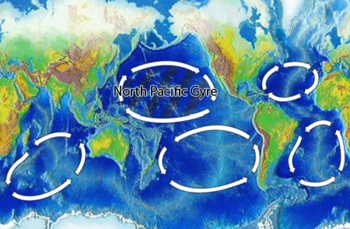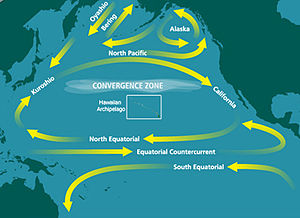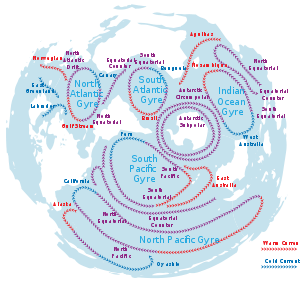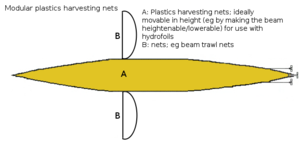- Great Pacific Garbage Patch
-
"Garbage Island" redirects here. For the episode of How I Met Your Mother, see Garbage Island (How I Met Your Mother).
 The Garbage Patch is located within the North Pacific Gyre, one of the five major oceanic gyres.
The Garbage Patch is located within the North Pacific Gyre, one of the five major oceanic gyres.
The Great Pacific Garbage Patch, also described as the Pacific Trash Vortex, is a gyre of marine litter in the central North Pacific Ocean located roughly between 135°W to 155°W and 35°N to 42°N.[1] The patch extends over an indeterminate area, with estimates ranging very widely depending on the degree of plastic concentration used to define the affected area.
The Patch is characterized by exceptionally high concentrations of pelagic plastics, chemical sludge, and other debris that have been trapped by the currents of the North Pacific Gyre.[2] Despite its size and density, the patch is not visible from satellite photography, since it consists primarily of suspended particulates in the upper water column. Since plastics break down to ever smaller polymers, concentrations of submerged particles are not visible from space, nor do they appear as a continuous debris field. Instead, the patch is defined as an area in which the mass of plastic debris in the upper water column is significantly higher than average.
Contents
Discovery
The Great Garbage Patch was predicted in a 1988 paper published by the National Oceanic and Atmospheric Administration (NOAA) of the United States. The prediction was based on results obtained by several Alaska-based researchers between 1985 and 1988 that measured neustonic plastic in the North Pacific Ocean.[3] This research found high concentrations of marine debris accumulating in regions governed by ocean currents. Extrapolating from findings in the Sea of Japan, the researchers hypothesized that similar conditions would occur in other parts of the Pacific where prevailing currents were favorable to the creation of relatively stable waters. They specifically indicated the North Pacific Gyre.[4]
Charles J. Moore, returning home through the North Pacific Gyre after competing in the Transpac sailing race in 1997, came upon an enormous stretch of floating debris. Moore alerted the oceanographer Curtis Ebbesmeyer, who subsequently dubbed the region the "Eastern Garbage Patch" (EGP).[5] The area is frequently featured in media reports as an exceptional example of marine pollution.[6] Moore's claim of having discovered a large, visible debris field is, however, a mischaracterization of the polluted region overall, since it consists primarily of particles that are generally invisible to the naked eye.[7]
A similar patch of floating plastic debris is found in the Atlantic Ocean. See: North Atlantic Garbage Patch.[8][9]
Formation
It is thought that, like other areas of concentrated marine debris in the world's oceans, the Great Pacific Garbage Patch formed gradually as a result of marine pollution gathered by oceanic currents.[10] The garbage patch occupies a large and relatively stationary region of the North Pacific Ocean bound by the North Pacific Gyre (a remote area commonly referred to as the horse latitudes). The gyre's rotational pattern draws in waste material from across the North Pacific Ocean, including coastal waters off North America and Japan. As material is captured in the currents, wind-driven surface currents gradually move floating debris toward the center, trapping it in the region.
The size of the patch is unknown, as large items readily visible from a boat deck are uncommon. Most debris consists of small plastic particles suspended at or just below the surface, making it impossible to detect by aircraft or satellite. Instead, the size of the patch is determined by sampling. Estimates of size range from 700,000 square kilometres (270,000 sq mi) to more than 15,000,000 square kilometres (5,800,000 sq mi) (0.41% to 8.1% of the size of the Pacific Ocean), or, in some media reports, up to "twice the size of the continental United States".[11] Such estimates, however, are conjectural based on the complexities of sampling and the need to assess findings against other areas.
Net-based surveys are less subjective than direct observations but are limited regarding the area that can be sampled (net apertures 1–2 m and ships typically have to slow down to deploy nets, requiring dedicated ship's time). The plastic debris sampled is determined by net mesh size, with similar mesh sizes required to make meaningful comparisons among studies. Floating debris typically is sampled with a neuston or manta trawl net lined with 0.33 mm mesh. Given the very high level of spatial clumping in marine litter, large numbers of net tows are required to adequately characterize the average abundance of litter at sea. Long-term changes in plastic meso-litter have been reported using surface net tows: in the North Pacific Subtropical Gyre in 1999, plastic abundance was 335 000 items km2 and 5.1 kg km2, roughly an order of magnitude greater than samples collected in the 1980s. Similar dramatic increases in plastic debris have been reported off Japan. However, caution is needed in interpreting such findings, because of the problems of extreme spatial heterogeneity, and the need to compare samples from equivalent water masses, which is to say that, if an examination of the same parcel of water a week apart is conducted, an order of magnitude change in plastic concentration could be observed.[12]
Further, although the size of the patch is determined by a higher-than-normal degree of concentration of pelagic debris, there is no specific standard for determining the boundary between the "normal" and "elevated" levels of pollutants to provide a firm estimate of the affected area.
In August 2009, the Scripps Institution of Oceanography/Project Kaisei SEAPLEX survey mission of the Gyre found that plastic debris was present in 100 consecutive samples taken at varying depths and net sizes along a 1,700 miles (2,700 km) path through the patch. The survey also confirmed that, while the debris field does contain large pieces, it is on the whole made up of smaller items that increase in concentration toward the Gyre's centre, and these 'confetti-like' pieces are clearly visible just beneath the surface.
Sources of pollutants
There is strong scientific data concerning the origins of pelagic plastics. The figure that an estimated 80% of the garbage comes from land-based sources and 20% from ships is derived from an unsubstantiated estimate.[13] Ship-generated pollution is a source of concern, since a typical 3,000-passenger cruise ship produces over eight tons of solid waste weekly, a major amount of which ends up in the patch, as most of the waste is organic.[14] Pollutants range in size from abandoned fishing nets to micro-pellets used in abrasive cleaners.[15] Currents carry debris from the west coast of North America to the gyre in about six years,[16] and debris from the east coast of Asia in a year or less.[17][18] An international research project led by Dr. Hideshige Takada of Tokyo University studying plastic pellets, or nurdles, from beaches around the world may provide further clues about the origins of pelagic plastic.[19]
Plastic photodegradation in the ocean
Main article: PhotodegradationThe Great Pacific Garbage Patch has one of the highest levels known of plastic particulate suspended in the upper water column. As a result, it is one of several oceanic regions where researchers have studied the effects and impact of plastic photodegradation in the neustonic layer of water.[20] Unlike debris, which biodegrades, the photodegraded plastic disintegrates into ever smaller pieces while remaining a polymer. This process continues down to the molecular level.[21]
As the plastic flotsam photodegrades into smaller and smaller pieces, it concentrates in the upper water column. As it disintegrates, the plastic ultimately becomes small enough to be ingested by aquatic organisms that reside near the ocean's surface. Thus, plastic waste enters the food chain through its concentration in the neuston.
Some plastics decompose within a year of entering the water, leaching potentially toxic chemicals such as bisphenol A, PCBs, and derivatives of polystyrene.[22]
Weight of plastics through water column
Charles Moore has estimated the mass of the Great Pacific Garbage Patch at 100 million tons.[23]
Density of neustonic plastics
The patch is not a visibly dense field of floating debris. The process of disintegration means that the plastic particulate in much of the affected region is too small to be seen. In a 2001 study, researchers (including Charles Moore) found concentrations of plastic particles at 334,721 pieces per km2 with a mean mass of 5,114 grams (11.27 lbs) per km2, in the neuston. Assuming each particle of plastic averaged 5 mm x 5 mm, this would amount to only 8 m2 per km2 due to small particulates. Nonetheless, this represents a very high amount with respect to the overall ecology of the neuston. In many of the sampled areas, the overall concentration of plastics was seven times greater than the concentration of zooplankton. Samples collected at deeper points in the water column found much lower concentrations of plastic particles (primarily monofilament fishing line pieces).[24]
Size and visibility
Although many media and advocacy reports have suggested that the patch extends over an area larger than the continental U.S., recent research sponsored by the National Science Foundation suggests the affected area may be twice the size of Hawaii,[25][26] while a recent study concluded that the patch might be smaller.[27] This can be attributed to the fact that there is no specific standard for determining the boundary between the "normal" and "elevated" levels of pollutants and what constitutes being part of the patch. The size is determined by a higher-than-normal degree of concentration of pelagic debris in the water. Recent data collected from Pacific albatross populations suggest there may be two distinct zones of concentrated debris in the Pacific.[28]
The patch is not easily visible because it consists of very small pieces, almost invisible to the naked eye [29], most of its contents are suspended beneath the surface of the ocean[30], and the relatively low density of the plastic debris at, in one scientific study, 5.1 kilograms of plastic per square kilometer of ocean area.[24]
Effect on wildlife
Some of these long-lasting plastics end up in the stomachs of marine birds and animals, and their young,[5] including sea turtles and the Black-footed Albatross.[31] Besides the particles' danger to wildlife, the floating debris can absorb organic pollutants from seawater, including PCBs, DDT, and PAHs.[32] Aside from toxic effects,[33] when ingested, some of these are mistaken by the endocrine system as estradiol, causing hormone disruption in the affected animal.[31] These toxin-containing plastic pieces are also eaten by jellyfish, which are then eaten by larger fish. Many of these fish are then consumed by humans, resulting in their ingestion of toxic chemicals.[34] Marine plastics also facilitate the spread of invasive species that attach to floating plastic in one region and drift long distances to colonize other ecosystems.[15]
Research has shown that this plastic marine debris affects at least 267 species worldwide and a few of the 267 species reside in the North Pacific Gyre.[35]
Research and cleanup
In April 2008, Richard Sundance Owen, a building contractor and scuba dive instructor, formed the Environmental Cleanup Coalition to address the issue of North Pacific pollution. ECC collaborates with other groups to identify methods to safely remove plastic and persistent organic pollutants from the oceans.[36][37]
The JUNK raft project was a trans-Pacific sailing voyage from June to August 2008 made to highlight the plastic in the patch, organized by the Algalita Marine Research Foundation.[38][39][40]
Project Kaisei is a project to study and clean up the garbage patch launched in March 2009. In August 2009, two project vessels, the Scripps Institution of Oceanography, spent 19 days on the ocean in August, 2009 researching the patch. Their primary goal was to describe the abundance and distribution of plastic in the gyre in the most rigorous study to date. Researchers were also looking at the impact of plastic on mesopelagic fish, such as lanternfish.[42][43][44] This group utilized a fully capable dedicated oceanographic research vessel, the 170 ft (52 m) long New Horizon .[45]
See also
- Indian Ocean Garbage Patch
- North Atlantic Garbage Patch
- Ecosystem of the North Pacific Subtropical Gyre
- Marine debris
- Plastic particle water pollution
References
- ^ See the relevant sections below for specific references concerning the discovery and history of the patch. A general overview is provided in Dautel, Susan L. "Transoceanic Trash: International and United States Strategies for the Great Pacific Garbage Patch," 3 Golden Gate U. Envtl. L.J. 181 (2009)
- ^ For this and what follows, see Moore (2004) and Moore (2009), which includes photographs taken from the patch,
- ^ Day, Robert H.; Shaw, David G.; Ignell, Steven E. (4). "Quantitative distribution and characteristics of neustonic plastic in the North Pacific Ocean. Final Report to US Department of Commerce, National Marine Fisheries Service, Auke Bay Laboratory. Auke Bay, AK" (PDF). pp. 247–266. http://swfsc.noaa.gov/publications/TM/SWFSC/NOAA-TM-NMFS-SWFSC-154_P247.PDF
- ^ "After entering the ocean, however, neuston plastic is redistributed by currents and winds. For example, plastic entering the ocean in Japan is moved eastward by the Subarctic Current (in Subarctic Water) and the Kuroshio (in Transitional Water, Kawai 1972; Favorite et al. 1976; Nagata et al. 1986). In this way, the plastic is transported from high-density areas to low-density areas. In addition to this eastward movement, Ekman stress from winds tends to move surface waters from the subarctic and the subtropics toward the Transitional Water mass as a whole (see Roden 1970: fig. 5). Because of the convergent nature of this Ekman flow, densities tend to be high in Transitional Water. In addition, the generally convergent nature of water in the North Pacific Central Gyre (Masuzawa 1972) should result in high densities there also." Day, etc... 1988, p. 261 (Emphasis added)
- ^ a b Moore, Charles (November 2003). Across the Pacific Ocean, plastics, plastics, everywhere. Natural History Magazine. http://www.mindfully.org/Plastic/Ocean/Moore-Trashed-PacificNov03.htm
- ^ Berton, Justin (October 19, 2007). "Continent-size toxic stew of plastic trash fouling swath of Pacific Ocean". San Francisco Chronicle (San Francisco: Hearst): pp. W–8. Friday, October 19. http://www.sfgate.com/cgi-bin/article.cgi?f=/c/a/2007/10/19/SS6JS8RH0.DTL. Retrieved 2007-10-22
- ^ See introduction, above
- ^ Lovett, Richard A. (2 March 2010). "Huge Garbage Patch Found in Atlantic Too". National Geographic News. National Geographic Society. http://news.nationalgeographic.com/news/2010/03/100302-new-ocean-trash-garbage-patch/.
- ^ Victoria Gill (24 February 2010). "Plastic rubbish blights Atlantic Ocean". BBC. http://news.bbc.co.uk/1/hi/sci/tech/8534052.stm. Retrieved 16 March 2010.
- ^ For this and what follows, see David M. Karl, "A Sea of Change: Biogeochemical Variability in the North Pacific Subtropical Gyre," Ecosystems, Vol. 2, No. 3 (May - Jun., 1999), pp. 181-214 and, for gyres generally, Sverdrup HU, Johnson MW, Fleming RH. 1946. The oceans, their physics, chemistry and general biology. New York: Prentice-Hall.
- ^ Marks, Kathy (2008-02-05). "The world's rubbish dump". The Independent (London). http://www.independent.co.uk/environment/the-worlds-rubbish-dump-a-garbage-tip-that-stretches-from-hawaii-to-japan-778016.html. Retrieved 2010-05-04.
- ^ Ryan, Moore et al (2009)HI
- ^ Postulated in Moore 2004
- ^ Clemmitt, Marcia. "New Rules Sought for 'Floating Cities.'" Saving the Oceans 15.39 (4 Nov. 2005): n. pag. CQ Researcher Online. Web. 5 Oct. 2009. <http://library.cqpress.com/cqresearcher/document.php?id=cqresrre2005110420&type=hitlist>.
- ^ a b Ferris, David (May/June 2009). "Message in a bottle". Sierra (San Francisco: Sierra Club). http://sierraclub.org/sierra/200905/message.aspx. Retrieved August 13, 2009
- ^ http://www.mindfully.org/Plastic/Ocean/Moore-Trashed-PacificNov03.htm
- ^ Faris, J. and Hart, K. (1994). Seas of Debris: A Summary of the Third International Conference on Marine Debris. N.C. Sea Grant College Program and NOAA
- ^ Garbage Mass Is Growing in the Pacific. National Public Radio. 2008-03-28. http://www.npr.org/templates/story/story.php?storyId=89099470
- ^ "International Pellet Watch". Laboratory of Organic Geochemistry, Dr. Hideshige Takada. http://www.tuat.ac.jp/~gaia/ipw/index.html. Retrieved 2009-05-27.
- ^ Thompson, Richard C.; Olsen, Y; Mitchell, RP; Davis, A; Rowland, SJ; John, AW; McGonigle, D; Russell, AE (2004-05-07). "Lost at Sea: Where Is All the Plastic?,". Science 304 (5672): 843. doi:10.1126/science.1094559. PMID 15131299. http://www.sciencemag.org/cgi/content/full/304/5672/838/DC1. Retrieved 2008-07-19.
- ^ For this and what follows, see the references provided at Photodegradation. Also, D.K.A. Barnes et al., Accumulation and fragmentation of plastic debris in global environments, Phil. Trans. R. Soc. B 27 July 2009 vol. 364 no.1526, 1985-1998 doi: 10.1098/rstb.2008.0205
- ^ Barry, Carolyn (2009-08-20). "Plastic Breaks Down in Ocean, After All -- And Fast". National Geographic News. National Geographic Society. http://news.nationalgeographic.com/news/2009/08/090820-plastic-decomposes-oceans-seas.html. Retrieved 2009-08-30.
- ^ "The world's rubbish dump: a tip that stretches from Hawaii to Japan," Kathy Marks AND Daniel Howden. 5 February 2008. Independent.co.uk [1] accessed 15 March 2011
- ^ a b Moore, Charles; Moore, S. L.; Leecaster, M. K.; Weisberg, S. B. (4). "A Comparison of Plastic and Plankton in the North Pacific Central Gyre" (PDF). Marine Pollution Bulletin 42 (12): 1297–1300. 2001-12-01. doi:10.1016/S0025-326X(01)00114-X. PMID 11827116. http://www.alguita.com/gyre.pdf
- ^ For a discussion of the problems in determining the exact size based on current sampling techniques, see Peter Ryan, Charles Moore et al., Monitoring the abundance of plastic debris in the marine environment. Phil. Trans. R. Soc. B 27 July 2009 vol. 364 no. 1526 1999-2012, doi: 10.1098/rstb.2008.0207
- ^ http://www.katu.com/outdoors/featured/112901159.html
- ^ "OCEANIC "GARBAGE PATCH" NOT NEARLY AS BIG AS PORTRAYED IN MEDIA", http://oregonstate.edu/ua/ncs/archives/2011/jan/oceanic-%E2%80%9Cgarbage-patch%E2%80%9D-not-nearly-big-portrayed-media
- ^ Young LC, Vanderlip C, Duffy DC, Afanasyev V, Shaffer SA (2009) Bringing Home the Trash: Do Colony-Based Differences in Foraging Distribution Lead to Increased Plastic Ingestion in Laysan Albatrosses? PLoS ONE 4(10): e7623. doi:10.1371/journal.pone.0007623
- ^ Cecil Adams Why don't we ever see pictures of the floating island of garbage? Straight Dope / Chicago Reader
- ^ Steve Gorman Scientists study huge plastic patch in Pacific Reuters
- ^ a b Moore, Charles (2002-10-02). Great Pacific Garbage Patch. Santa Barbara News-Press
- ^ Rios, L.M.; Moore, C. and Jones, P.R. (2007). "Persistent organic pollutants carried by Synthetic polymers in the ocean environment". Marine Pollution Bulletin 54 (8): 1230–1237. doi:10.1016/j.marpolbul.2007.03.022. PMID 17532349
- ^ Tanabe, S.; Watanabe, M., Minh, T.B., Kunisue, T., Nakanishi, S., Ono, H. and Tanaka, H. (2004). "PCDDs, PCDFs, and coplanar PCBs in albatross from the North Pacific and Southern Oceans: Levels, patterns, and toxicological implications". Environmental Science & Technology 38 (2): 403–413. doi:10.1021/es034966x
- ^ Rogers, Paul. "'Pacific Garbage Patch' expedition finds plastic, plastic everywhere." The Contra Costa Times [Walnut Creek, CA] 1 Sept. 2009: n. pag. Web. 4 Oct. 2009. <http://www.contracostatimes.com/search/ ci_13258216?nclick_check=1>.
- ^ http://oceans.greenpeace.org/raw/content/en/documents-reports/plastic_ocean_report.pdf
- ^ Bradshaw, Kate (January 29, 2009). "The Great Garbage Swirl". Maui Time Weekly (Maui: Linear Publishing). http://www.mauitime.com/Articles-i-2009-01-29-68584.113117_The_great_garbage_swirl.html. Retrieved April 26, 2009
- ^ The Environmental Cleanup Coalition's "Gyre Cleanup" plan
- ^ Yap, Britt (2008-08-28). "A raft made of junk crosses Pacific in 3 months". USA Today. Archived from the original on 2009-09-30. http://www.webcitation.org/5kBAZoJrO. Retrieved 2009-09-30.
- ^ "Raft made of junk bottles crosses Pacific". msnbc. 2008-08-28. Archived from the original on 2009-09-30. http://www.webcitation.org/5kBAjTVWI. Retrieved 2009-09-30.
- ^ Jeavans, Christine (2008-08-20). "Mid-ocean dinner date saves rower". BBC News. Archived from the original on 2009-09-30. http://www.webcitation.org/5kBAnV1JI. Retrieved 2009-09-30.
- ^ Walsh, Bryan (1 August 2009). "Expedition Sets Sail to the Great Plastic Vortex". Time. http://www.time.com/time/health/article/0,8599,1914145,00.html. Retrieved 2 August 2009.
- ^ "SEAPLEX Day 11 Part 1: Midwater Fish « SEAPLEX". Seaplexscience.com. 2009-08-12. http://seaplexscience.com/2009/08/12/midwater_fish/. Retrieved 2010-07-28.
- ^ Staff Writers. "Scientists Find 'Great Pacific Ocean Garbage Patch.'" Space Daily 2 Sept. 2009: n. pag. Gale. Web. 12 Oct. 2009
- ^ "GaleNet". Find.galegroup.com. http://find.galegroup.com. Retrieved 2010-07-28.
- ^ http://shipsked.ucsd.edu/Ships/New_Horizon/specs.php http://sio.ucsd.edu/Expeditions/Seaplex/Science/
Further reading
- Oliver J. Dameron; Michael Parke, Mark A. Albins and Russell Brainard (April 2007). "Marine debris accumulation in the Northwestern Hawaiian Islands: An examination of rates and processes". Marine Pollution Bulletin 54 (4): 423–433. doi:10.1016/j.marpolbul.2006.11.019. PMID 17217968.
- Rei Yamashita; Atsushi Tanimura (2007). "Floating plastic in the Kuroshio Current area, western North Pacific Ocean". Marine Pollution Bulletin 54 (4): 485–488. doi:10.1016/j.marpolbul.2006.11.012. PMID 17275038.
- Masahisa Kubota; Katsumi Takayama and Noriyuki Horii (2000). "Movement and accumulation of floating marine debris simulated by surface currents derived from satellite data" (PDF). School of Marine Science and Technology, Tokai University. http://www.aviso.oceanobs.com/fileadmin/documents/OSTST/2000/kubota.pdf.
- Gregory, M.R.; Ryan, P.G. (1997). "Pelagic plastics and other seaborne persistent synthetic debris: a review of Southern Hemisphere perspectives". In Coe, J.M., Rogers, D.B.. Marine Debris: Sources, Impacts, Solutions. New York: Springer-Verlag. pp. 49–66.
- A comparison of plastic and plankton in the North Pacific Central Gyre — Charles J Moore, Shelly L Moore, Molly K Leecaster and Stephen B Weisberg
- Density of plastic particles found in zooplankton trawls from coastal waters of California to the North Pacific Central Gyre — Charles J Moore, Gwen L Lattin and Ann F Zellers
- The quantitative distribution and characteristics of neuston plastic in the North Pacific Ocean, 1984-1988 — R H Day, D G Shaw and S E Ignell (1988)
- Thomas Morton, 'Oh, This is Great, Humans Have Finally Ruined the Ocean', Vice Magazine, Vol. 6, No. 2 (2007), pp. 78–81.
- Moby-Duck: The True Story of 28,800 Bath Toys Lost at Sea by Donovan Hohn
- Hoshaw, Lindsey (2009-11-09). "Afloat in the Ocean, Expanding Islands of Trash". New York Times. http://www.nytimes.com/2009/11/10/science/10patch.html?_r=1&hpw. Retrieved 2009-11-10.
External links
- Pacific Garbage Patch International Treaty
- greatgarbagepatch.org
- Pacific Garbage Patch - Smithsonian Ocean Portal
- "Plastic Surf" The Unhealthful Afterlife of Toys and Packaging: Small remnants of toys, bottles and packaging persist in the ocean, harming marine life and possibly even us by Jennifer Ackerman Scientific American August 2010
- photographer Chris Jordan, who recently traveled to a remote part of the Pacific Ocean to document effects of the world's largest known mass of garbage. in Seed (magazine) Boustead, Greg (2010-02-18). "§ Appetite for Destruction". Seedmagazine.com. http://seedmagazine.com/slideshow/appetite_destruction/. Retrieved 2010-07-28.
- Scripps Environmental Accumulation of Plastic Expedition (SEAPLEX) — Scripps Institution of Oceanography, UC San Diego
- The Project Kaisei Voyage Tracker — Project Kaisei and Ojingolabs
- 5 Gyres - Understanding Plastic Marine Pollution — Algalita, Livable Legacy
- The trash vortex — Greenpeace
- Navigating the Pacific's 'Garbage Patch' — National Public Radio and me
- Marine Research, Education and Restoration — Algalita Marine Research Foundation
- Images & video from the North Pacific gyre — WordPress.com
- Sea of Trash - New York Times Magazine
- Captain Charles Moore on the seas of plastic
- Charles Moore: Sailing the Great Pacific Garbage Patch - TED Conference talk (2009)
- Skeptoid #132: The Sargasso Sea and the Pacific Garbage Patch at Skeptoid
- E-Mails From the Great Pacific Garbage Patch by Laurie David, The Huffington Post, June 15, 2009
- PSA Video: "Plastics Kill" by The Surfrider Foundation's Rise Above Plastics Program
- The Plastiki on Twitter
Coordinates: 38°N 145°W / 38°N 145°W
Ocean currents and gyres Currents - East Greenland
- Norwegian
- Transpolar Drift Stream
- Agulhas
- Angola
- Antilles
- Azores
- Baffin Island
- Benguela
- Brazil
- Canary
- Cape Horn
- Caribbean
- East Greenland
- East Iceland
- Falkland
- Florida
- Guinea
- Gulf Stream
- Irminger
- Labrador
- Lomonosov
- Loop
- North Atlantic
- North Brazil
- North Equatorial
- Norwegian
- Portugal
- Slope Jet
- South Atlantic
- South Equatorial
- Spitsbergen
- West Greenland
- Agulhas
- East Madagascar
- Equatorial Counter Current
- Indian Monsoon Current
- Indonesian Throughflow
- Leeuwin
- Madagascar
- Mozambique
- Somali
- South Australian
- South Equatorial
- West Australian
Gyres Major gyres- Indian Ocean Gyre
- North Atlantic Gyre
- South Atlantic Gyre
- North Pacific Gyre
- South Pacific Gyre
Other gyres- Beaufort Gyre
- Ross Gyre
- Weddell Gyre
Related - Atmospheric circulation
- Boundary currents
- Coriolis effect
- Ekman transport
- Great Pacific Garbage Patch
- Indian Ocean Garbage Patch
- Marine debris
- North Atlantic Garbage Patch
- Ocean
- Thermohaline circulation
Categories:- Marine garbage patches
- Pacific Ocean
- Plastics and the environment
Wikimedia Foundation. 2010.



